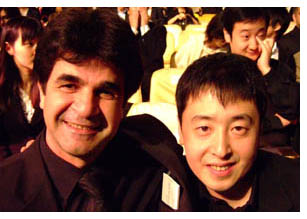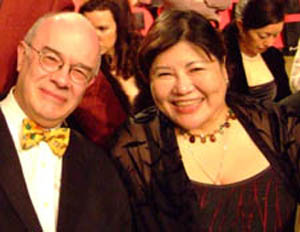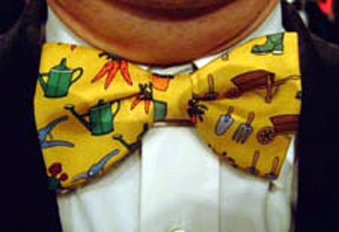Archive for the 'Directors: Bong Joon-ho' Category
A welcome INFLUENZA
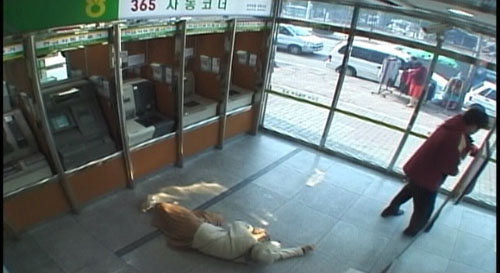
DB here:
Kristin and I are en route to the Vancouver International Film Festival, after a few days in Seattle visiting Sanjeev and Megan, nephew and niece-in-law. We were completely awestruck by the vast holdings of Scarecrow Video, where even the Warner Archives special-order DVDs can be rented. We also had a good long talk over JaK steaks with Jim Emerson, impresario of the superb website Scanners. Not to mention catching a screening of the lively Walt & El Grupo at the Seattle International Film Festival theatre. As a big fan of Saludos Amigos and Three Caballeros, I was thrilled to learn the background story, as well as to watch gorgeous 16mm Kodachrome footage.
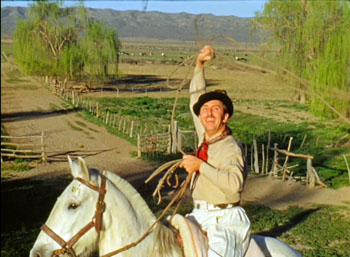
Last year’s trip to Vancouver put us on the road for thirteen days, encountering movie-related stuff (and Obama) in surprising places. This time we took the plane—faster but less relaxing. To get a better look at the landscape, we’ll be taking a train up to Vancouver.
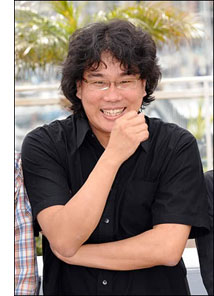 One of the films I’m most looking forward to at Vancouver is Bong Joon-ho’s Mother, brought to this year’s event by Tony Rayns. Alas, Bong himself will not be joining us. I enjoyed meeting him at my first Vancouver visit in 2006, when this blog was in swaddling clothes. He’s completely frank and unpretentious.
One of the films I’m most looking forward to at Vancouver is Bong Joon-ho’s Mother, brought to this year’s event by Tony Rayns. Alas, Bong himself will not be joining us. I enjoyed meeting him at my first Vancouver visit in 2006, when this blog was in swaddling clothes. He’s completely frank and unpretentious.
Even before meeting him, I had followed Bong’s career with keen interest. I think he’s one of the best Korean directors, though he probably doesn’t get as much attention as some others. Like the Japanese Kore-eda Hirokazu, Bong is the sort of quiet genre-hopper who’s hard to pin down. His first feature, Barking Dogs Never Bite, is a charming romantic comedy that also offers a portrait of neighborhood life. The mordant Memories of Murder (2003) quietly bends the conventions of the city-cop-in-a-village movie, mixing comedy into a serial-killer tale. Bong’s biggest commercial success came with The Host (2006), a monster movie in the grand tradition that manages to be at once scary, funny, and socially critical. Seeing it again this summer, I was struck by its compact elegance. Bong makes complex narrative and stylistic twists look easy.
Bong has also made some acute short films; he seems to understand that they require the snappy impact of a well-wrought short story. Probably his best-known short is the “Shaking Tokyo” segment of the omnibus movie Tokyo (2008). It focuses on a hikikomori, a young man who has withdrawn from social contact and lives wholly through the TV monitor and the computer screen. Bong’s hero tidily stacks empty pizza boxes along his walls like installation art. Only an encounter with a delivery woman makes him question his robotic seclusion. The ending, which lures our hero outside, provides a Twilight-Zoneish twist.
More single-minded, though, is a short I’ve just seen, the little-known Influenza (2004). There are several movies based on surveillance-camera footage; one of the most lyrical, Optical Vacuum, I reviewed here. Bong went instead for narrative. He staged a story in locales covered by surveillance cameras, and then retrieved the footage from the hours of material. Cut together, the shots follow Mr. Cho, a failed salesman who turns to petty theft and violent crime.
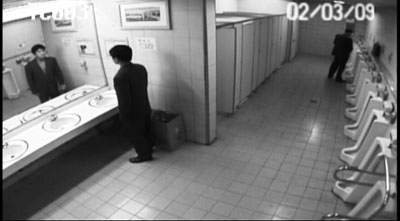
We discover Mr. Cho in men’s rooms, car parks, and ATM stations. The scenes, each shot in a single take, run through various spycam techniques: fixed high angle, black and white imagery, stuttering motion, mechanical scanning of the scene (sometimes leaving the main action behind). We see wide-angles, telephoto shots, barely legible long-shots, and split-screen imagery picking out opposite points of view.
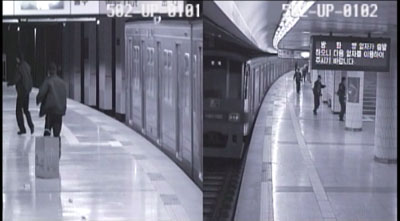
Everything we see is staged, I think. Unrehearsed events seldom look this cogent and poised. Yet sometimes, especially during the climactic crowd scene, some of the action seems to have been left to luck.
Short but not sweet—mostly sour—Influenza shows what an ingenious filmmaker can do by setting himself a single, precise problem. Crossing the border between commercial fiction and avant-garde experimentation, the film deserves wider circulation.
As for Mother, Derek Elley’s Variety review promises the trademark Bong blend of gentle comedy and unsettling drama. And Vancouverites have an extra bit of luck: A program of shorts by Bong and his colleagues from the Korean Academy of Film Arts graces the festival this year. Bong’s next planned project, about the wretched survivors of a new Ice Age, shows him to be as unpredictable and unclassifiable as ever.
Thanks to Bong Joon-ho for his help in preparing this entry. The trailer for Walt & El Grupo is here. And there’s a poignant story of the founding and near-demise of Scarecrow Video here.
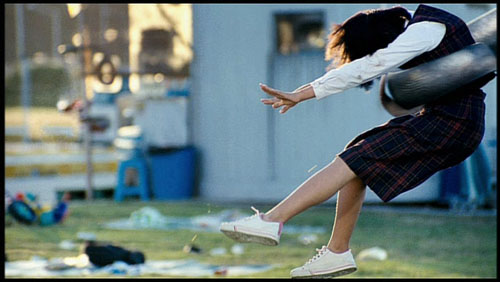
The Host.
A many-splendored thing 11: Portraits
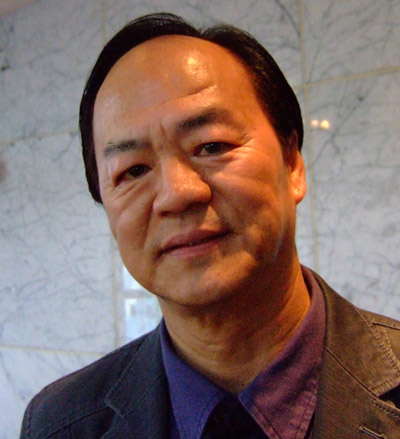
DB here:
Some miscellaneous glimpses of people I’ve run into at the Hong Kong International Film Festival. If the notion of six degrees of separation holds good, chances are you know some of them, or someone you know does.
Up top, the great actor Ti Lung, remembered from Chang Cheh films and perhaps most famous for his role as the honor-bound brother in John Woo’s A Better Tomorrow.
Below, Russell Edwards, Variety critic and reporter, with Bérénice Reynaud, programmer (San Sebastian festival, RedCat), professor (Cal Arts), and critic (author of books on Chinese film and on Hou’s City of Sadness).
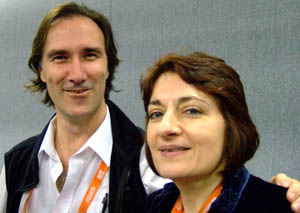
Li Cheuk-to, one of Hong Kong’s most distinguished film critics and Artistic Director of the festival. Ah-to is at the center of HK film culture, having founded the Critics Society and played a central role in the festival for decades. This shot on the Star Ferry catches him in an unusual moment of calm; normally he’s doing nine things at once.
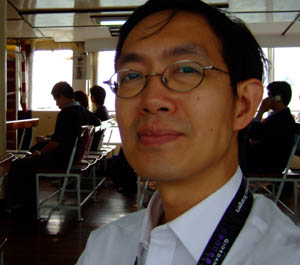
Ivy Shiau, Operations Manager of the festival, starting to set up the room for press and guests.
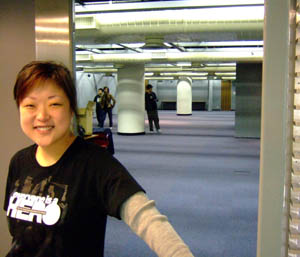
Subway Cinema boys on the go: at Kubrick, Grady Hendrix deals while Goran Topalovic buys books.
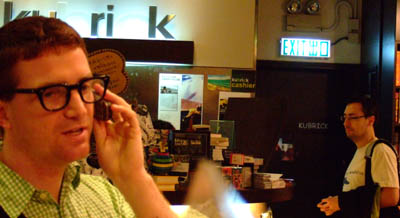
On the set of Triangle: Simon Yam chats with Twitchfilm‘s correspondent Todd Brown.
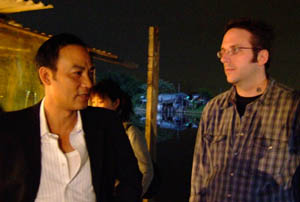
Also on the Triangle shoot: Kelly Lin and Antoine Thirion (Cahiers).
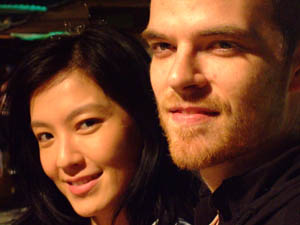
At the reception for the Asian Film Awards: Ho Yuhang (Rain Dogs) and Bong Joon-ho, who would win big with The Host.
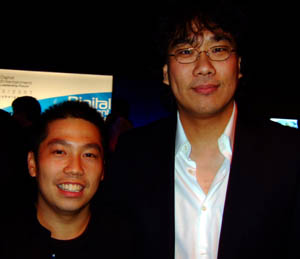
Killing time between screenings at an outdoor cafe: Grace Mak, Hong Kong critic doing graduate work at the University of Singapore, and Nat Olsen, film and music maestro. A graduate of UW, he’s dj-ing all over Asia and hosting the site Hong Kong Hustle.
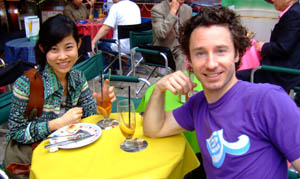
Here’s Sam Ho, Head Programmer at the Hong Kong Film Archive, keeping cool as we wait in line for a screening.
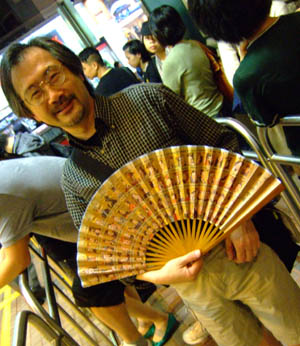
Here’s Yvonne Teh of Penang, huge fan of Asian film and proprietor of the Webs of Significance blog.
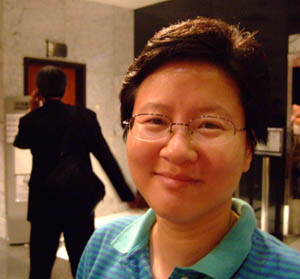
Note how my background skilfully keeps the cellphone motif going. Actually, if you photograph anything here but marine life, somebody with a mobile will be in the shot.
Jupiter Wong is the HK film industry’s top still photographer and the wildest man I’ve ever met. Upon meeting me this year, he said, “Why do you look so old?” He has gotten a haircut, but otherwise there’s no sign of domestication.
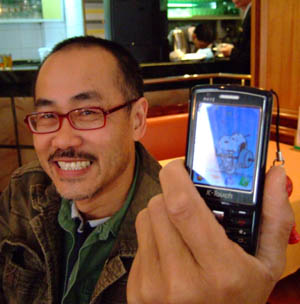
I met Athena Tsui when I first came to Hong Kong twelve years ago. A graduate of U Toronto, she has worked in many phases of film production, distribution, and exhibition. She routinely helps out the festivals with translation, guest wrangling, and planning. She’s been my supreme guide to HK film insiders’ gossip and to Mongkok shopping.
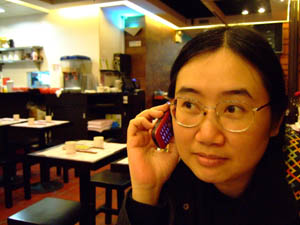
I couldn’t attend the talk given by Jean-Michel Frodon, editor of Cahiers du cinema, but I did see him outside another event. We first met in Shanghai and keep running into each other at various festivals.
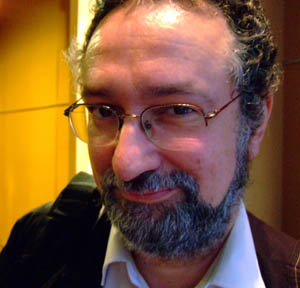
Another old friend, Virginia Wright Wexman of Chicago, was leading a group of visitors to the festival. The smile is doubtless the result of her recent retirement from the University of Illinois–Chicago.
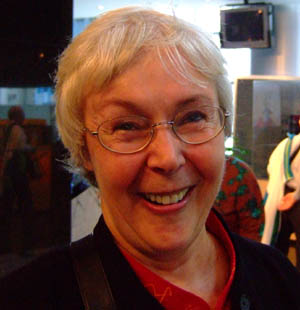
Peter Tsi is the boss of it all, the Executive Director of the Festival. You can usually find him multitasking.

Shu Kei, another friend from my first visit, is head of Film at the Academy for the Performing Arts. He has done everything–made films (see especially A Queer Story), distributed them, programmed the festival, and taught film aesthetics and production. His knowledge of cinema is encyclopedic.
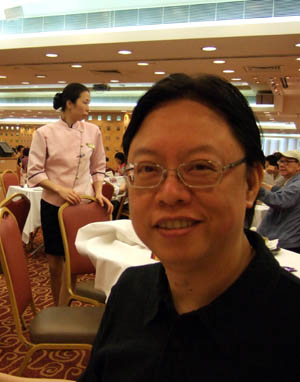
Akiko Tetsuya is a perennial HKIFF presence. She has done a wonderful book on Brigitte Lin.
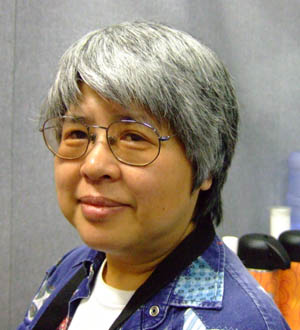
Shelly Kraicer founded one of the first Chinese cinema websites. He’s a prolific writer and an active consultant on Chinese film for Venice, Vancouver, and other festivals.
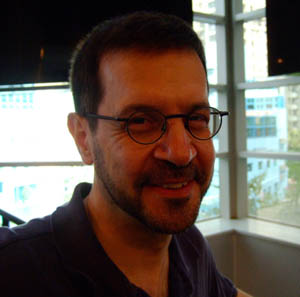
The very first person I came to know when visiting the festival in ’95 was the warm and generous Michael Campi. Michael is a pharmacist by trade and a devoted cinephile and festival consultant in his native Australia.
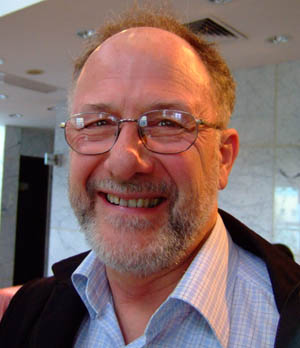
Frederic Ambroisine is an editor of the Paris magazine Kumite and is a busy producer of documentaries on Chinese cinema. If you own French editions of the Shaolin Monastery or One-Armed Swordsman series, you have bonus materials prepared by Fred. Below he’s rejoicing in his purchase of Cutie Honey action figures.
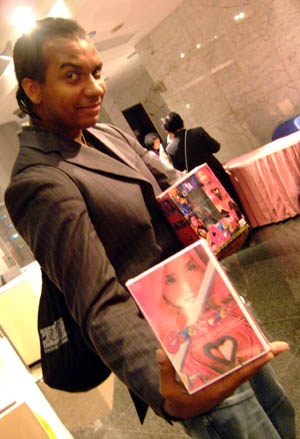
Other folks’ pix can be found if you trawl back through my previous entries. To all those whom I failed to snap, or whose shots didn’t come out well, I apologize. But all the more reason for you to return next year. Fame awaits you!
Speaking of other years….Two regular guests and old friends couldn’t attend this spring, so I can’t resist slipping in shots of them from the 2006 festival. First, Mike Walsh of Flinders University, Australia (and a UW grad).
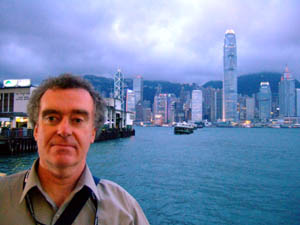
And here’s Peter Rist of Montreal’s Concordia University, at last year’s launch of the book on Milkyway Image.
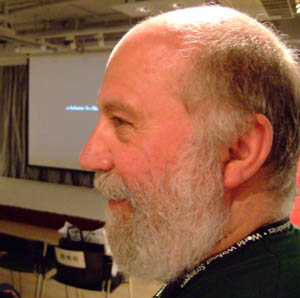
Finally, a shot of the wonderful Lisa Lu, star of many Shaws productions and other major pictures, such as Bertolucci’s Last Emperor. You can see her in a Li Han-hsiang frame I posted earlier.
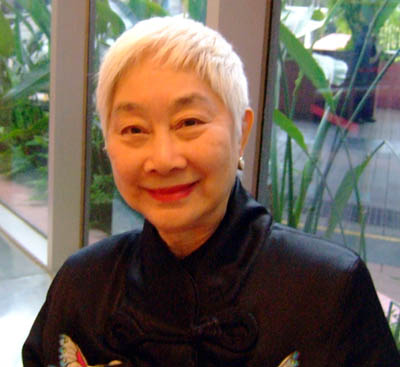
I can hardly believe that the festival is coming to an end. I leave for home on Thursday, but I hope to tack on one more entry before I go.
A many-splendored thing 2: Awards aplenty
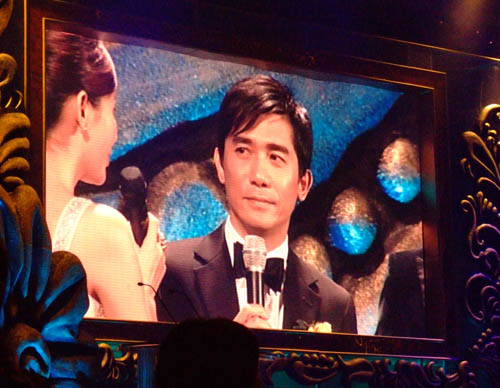
Short version:
This year the Hong Kong Entertainment Expo has launched the Asian Film Awards, a celebration of outstanding films and filmmakers created by the HK International Film Festival. Over 700 films were sifted by a jury and a handful of finalists were chosen in several categories. At the ceremony on Tuesday night, Bong Joon-ho’s The Host, which I wrote about at Vancouver’s film festival, won several: best film, best actor (Song Kang-ho, the put-upon father of the family), best cinematographer (Kim Hyung-goo), and best visual effects (The Orphanage). Best director honors went to Jia Zhang-ke for Still Life. Other winners:
Best actress: Miki Nakatani (Memories of Matsuko)
Best screenply: Mani Hagighi (Men at Work)
Best production design: Tim Yip (The Banquet)
Best musical score: Rahayu Supanggah (Opera Jawa)
Best editing: Lee Chatametikool (Syndromes and a Century)
A special award for Outstanding Contribution to Asian Cinema went to the great actress Josephine Siao Fong-Fong, presented by Luc Besson in an eloquent tribute.
I was fortunate enough to be given an award for Excellence in Asian Film Scholarship.
Long version follows.
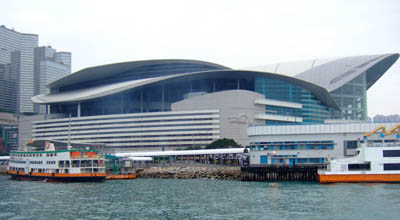
Tuesday morning-early afternoon: The film market, Filmart, is held in the overwhelming Convention Center on the harbor: at least seven floors of steel and glass, shaped like a wingspread gull and full of gigantic auditoria and meeting rooms. Sellers have set up booths to showcase films, TV shows, and the like. There’s also a film financing forum, where directors come to pitch projects to likely funders.
After getting my credentials, I shmoozed with old friend Shelley Kraicer, a Chinese film expert who’s a consultant for several festivals. I also spent time with Ho Yuhang, whose Rain Dogs I’d seen at Vancouver. Ho is a great fan of film noir, and I brought him some DVDs that seemed up his alley. He’s planning a psychological crime drama for his next project, and don’t be surprised if touches of David Goodis and Jim Thompson show up in it.
Late afternoon: After climbing into a suit, back to the Convention Center. At the preshow reception, met Fred Milstein, who works as a completion guarantor at Cine Finance; Fred went to film school, so we had several friends in common.
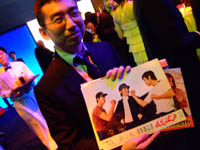
Also reunited with King Wei-chu, a programmer for Montreal’s wonderful Fantasia film fest, and Frédéric Amboisine, passionate adherent of Asian cinema and writer for the lush French magazine Kumite. (King and Frédéric awed me with the memorabilia they tote around, rare posters and books they’ll whip out to show you.)
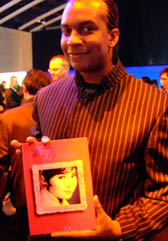
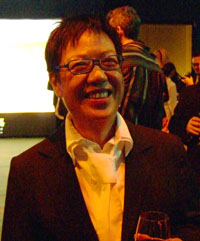
Also ran into director Ann Hui, looking happy and relaxed as usual. Ann, who’s one of Hong Kong’s best filmmakers, visited UW-Madison to show Summer Snow back in the 1990s.
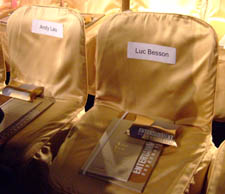
Evening: The ceremony approached. We spilled into the auditorium, with assigned seats. Mine was in the front row, and as I passed the center section I saw plenty of indications of star power.
I was lucky enough to be seated beside the remarkable Iranian director Jafar Panahi (The Circle, Offside) and next to him was Jia Zhang-ke, who remembered me from a panel we’d been on together in Shanghai. You can see that they were in good spirits. On my other side sat Vicki Zhou Wei and Song Kang-ho.
Before the curtain rose, I caught up with Tony Rayns, wearing an amazingly horticultural bow tie, and Peggy Chiao, the godmother of the New Taiwanese Cinema.
The big noise of the night was the presence of Korean pop star Rain, who brought shrieks from the crowd whenever he turned his head. Still, there was no shortage of fan response for Andy Lau and Tony Leung, the spokesman for Entertainment Expo.
The ceremony was principally in English, from a clever script written by the resourceful Grady Hendrix. Karen Mok started things off in her plummy English accent, but then David Wu showed up with his rapid-fire patter, eventually joined by Fiona Sit.
I missed some stretches because I had to go backstage before my award, but here are some pictures before and after. First, Mani Haghighi gets his screenplay award.
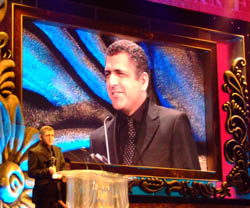
Here’s Siao Fong-Fong getting her special award:
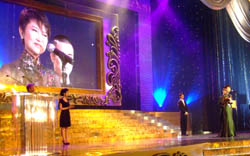
And here’s the Korean contingent as they realize they’re on a roll:
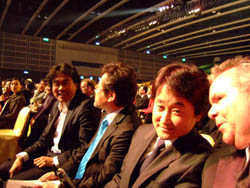
Late evening: At the afterparty, in a bar called JJ’s, I met with Grady, Stuart Levy of Tokyo Pop (who grasped the importance of Asian pop culture before nearly anybody else), his Japanese associate Matsuhashi Masashi, and several other folks—not least the indispensable Athena Tsui, who had worked very hard to make the Awards show a success. On the way out, got my picture taken with the charming Song Kang-ho.
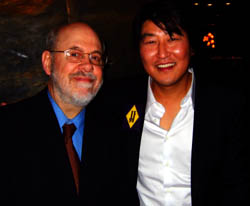
Later evening: Quiet dinner at a great fish restaurant with pals Yuhang and Michele, including Tony Rayns sans bowtie. We had some fine dishes, including pissing prawn (don’t ask).
Finally: Say hello to my lee’l fren’. The awards statuettes were designed by Wong Kar-wai art director William Chang.
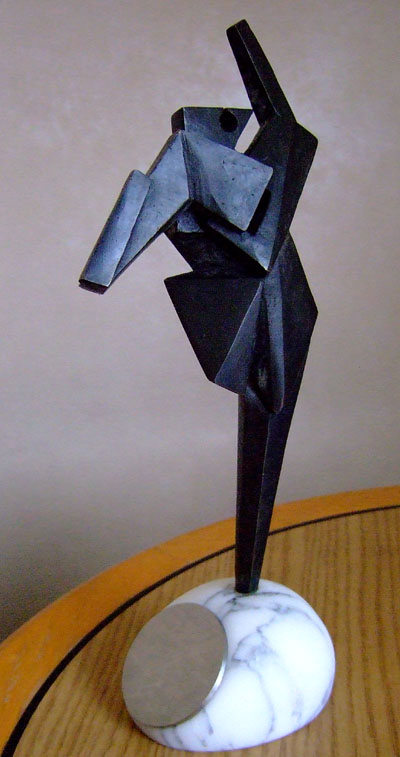
In the spirit of awards ceremonies: Thanks to everyone who’s helped me work on Asian film over the years, especially Tony Rayns, Donald Richie, Komatsu Hiroshi, Li Cheuk-to, Athena Tsui, Shu Kei, Sam Ho, Ding Yuin Shan, Stephen Teo, Doug Gomery, and Gabrielle Claes, along with several archives, festivals, and film distributors. Thanks also to Mr. Johnnie To, who kindly presented me with the award.
Updates and outtakes (in which we try, perhaps in vain, to catch up with ourselves)
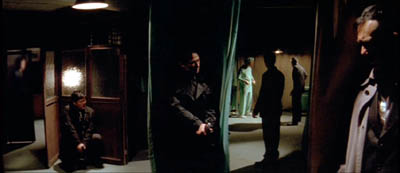
Exiled
Kristin writes:
“The Hobbit Film: New Developments” (January 13, 2007)
In this entry I discussed Bob Shaye’s recent claim that Peter Jackson would never get a chance to direct The Hobbit for New Line. I mentioned that one of the factors involved in the negotiations about who would direct is that the production rights will eventually revert to producer Saul Zaentz. I didn’t know the length of the option on those rights, which New Line currently holds. The January issue of the fantasy/sci fic magazine Locus says that the rights will revert to Zaentz in 2009.
Zaentz had owned the rights since the mid-1970s and sold them to Miramax in early 1997. Miramax had the two-film version of The Lord of the Rings in pre-production for about 18 months and then sold the rights to New Line in August of 1998. I don’t know what the source of Locus’ information is, but a twelve-month option would seem pretty plausible.
If that information is correct, New Line only has about two years to get the actual making of the film underway. It takes years for any big film to lumber into production in Hollywood these days, so the studio doesn’t have a lot of room to wiggle.
“By Annie Standards” (December 14, 2006)
Here I talked about methods for publicizing animated features. One way, I suggested, would be to foster audience interest in the various animation awards other than the Oscars. I remarked, “Under Academy rules, only three animated features can be nominated in any year unless sixteen or more such features are released that year. Then the number of nominations jumps to five, but so far that hasn’t happened. It may finally happen this year, if all sixteen features currently under consideration qualify under Academy rules.”
Close, but not close enough. On January 11, Variety announced that one film, Luc Besson’s Arthur and the Invisibles, had been disqualified as an animated feature. To qualify, a film must have at least 75% animated footage, and Arthur has too much live action.
With the number of qualifying features down to fifteen, only three can be nominated. Probably Cars will win, as I predicted in the original entry. It just won the Golden Globe in the newly established Animated Film category.
“Snakes, No, Borat, Yes: Not All Internet Publicity Is the Same” (January 7, 2007)
Here I suggested some reasons why Snakes on a Plane failed at the box office and Borat: Cultural Learnings of America for Make Benefit Glorious Nation of Kazakhstan succeeded, despite the fact that both garnered considerable fan-generated publicity on the internet. I mentioned that Sacha Baren Cohen had appeared on talk shows in character as Borat rather than in persona proper: “Each appearance by “Borat,” supposedly there to talk about the film, ended up being a hilarious performance by Cohen, ad-libbing on everything around him—the chairs, the coffee mugs, the cameras, the audience. Spectators ended up with one impression about the film: it was about this incredibly funny guy doing incredibly funny things.”
Trying to correct the widespread assumption that Borat was an improvised film, the January 8-14 issue of Variety ran a story about how Cohen worked with three scriptwriters, Peter Baynham, Dan Mazer, and Anthony “Ant” Hines: “The scribes even concoct Cohen’s dialogue for his promo appearances on ‘The Tonight Show’ and ‘Live With Regis and Kelly.’” Although Cohen presumably ad-libs to meet specific circumstances of each talk show, the publicity appearances are even more controlled by Cohen than I had assumed.
I also remarked that it is difficult to judge the degree to which the film manipulated the scenes of Borat’s encounters with real people. Especially in terms of editing and sound techniques, there was clearly much opportunity for this manipulation. The same Variety story goes on to say, “Much of the script had to be altered depending on how situations unravel. This means the writers ultimately end up producing the equivalent of multiple scripts, much of which ends up on the cutting room floor.” I’m not sure how chunks of scripts can end up on the cutting-room floor, but the point is that the filmmakers were carefully stitching the “documentary” scenes together on the script level and presumably would do so through stylistic means as well.
David writes:
Back to the Hotel
The Uchoten Hotel (aka Suite Dreams, blogged here) has acquired yet another English-language title: Hotel Avanti. It made it to #93 on Variety‘s list of the world’s 100 top-grossing films, with $51 million box office in Japan and none yet recorded overseas.
Speaking of Variety‘s list, the highest-grossing non-English language item turns out to be Bong Joon-ho’s Korean hit The Host (#59 at $84 million), due out in the US any month now. Only ten non-English-speaking films made the top 100, and of those, three were European (including Volver) but all the rest were Asian: Chinese (Fearless), Korean (The Host and King and Clown), and Japanese (Tales from Earthsea, Umizaru 2 Limit of Love, Hotel Avanti, and Japan Sinks–no rude remarks, please).
The entire list is in the 15-21 January hard copy of Variety, p. 15, but evidently it isn’t yet available on the paper’s site.
More on Johnnie To
In an earlier blog I praised Johnnie To as a director who shot and cut PTU smoothly and crisply. I waited through the fall, hoping somehow to see To’s latest, Exiled, on the big screen at one festival or another. No such luck. So last night I broke down and watched the DVD. Making full use of the widescreen format, To shows that classic technique can be at once rigorous and imaginative.
Exiled was more visually engaging than any US film I can recall last year, including Miami Vice. It immediately became my Best Film of 2006 That I Saw in 2007. (Runner-up: Children of Men.) I visited Milkyway while the film was being shot, and I hope to blog about the result in a future entry.
At Large on the Internets
On this very site, I’ve posted a new essay on action movies.
Annie Frisbie interviewed me for the Zoom-In podcast here. Annie is also blogging/reviewing Sundance films here.
Fox Independent visited Madison and posted videos on its site. The setup and the interview with filmmaker and teacher Erik Gunneson are here. An interview with me is here.












